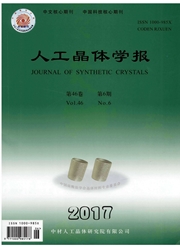

 中文摘要:
中文摘要:
采用甚高频等离子化学气相沉积技术(VHF—PECVD)制备了系列p-i—n型微晶硅太阳电池,研究了电池有源层硅烷浓度的变化对电池性能的影响。结果发现:随着硅烷浓度的提高电池的短路电流密度先提高然后降低,转换效率与之有相同的变化趋势,而开路电压随硅烷浓度的提高而增加,这些变化来源于有源层材料结构的改变。电池的填充因子几乎不受硅烷浓度的影响,但受前电极的影响很大。不同系列电池转化效率的最高点虽然处于非晶到微晶的过渡区,但对应电池的晶化率不同。另外,研究结果也给出非晶/微晶过渡区随着辉光功率的提高和沉积气压的降低向高硅烷浓度方向转移。
 英文摘要:
英文摘要:
Several series of p-i-n solar cells were prepared by very high frequency plasma enhanced chemical vapor deposition (VHF-PECVD) technique. The effect of silane concentration of the active layer on the performance of microcrystalline solar cells was investigated. The results indicate that both short circuit density (Jsc) and conversion efficiency increase firstly and then decrease with the increase of silane concentration. However the open circuit voltage (Voc) increases with increasing the silane concentration. These changes result from the structural change of active layer. The silane concentration has little effect on the fill factor of solar cells. But it is strongly affected by the type of front electrode. They have different crystalline volume fractions (Xc) although the optimum points of conversion efficiency of solar cells are all located at the transition zone from amorphous silicon to microcrystalline silicon. In addition, the results also demonstrate that the transition zone shifts to the higher silane concentration with increasing discharge power or decreasing deposition pressure.
 同期刊论文项目
同期刊论文项目
 同项目期刊论文
同项目期刊论文
 Influence of front electrode and back reflector electrode on the performances of microcrystalline si
Influence of front electrode and back reflector electrode on the performances of microcrystalline si Study of space voltage distribution between large-area parallel-plate electrodes for very high frequ
Study of space voltage distribution between large-area parallel-plate electrodes for very high frequ Study on the optical and electrical properties of plasma for the deposition of microcrystalline sili
Study on the optical and electrical properties of plasma for the deposition of microcrystalline sili Study of one-dimensional spatial distribution of the plasma luminous radicals during depositing sili
Study of one-dimensional spatial distribution of the plasma luminous radicals during depositing sili Modeling and experiments of high-pressure VHFSiH4/H-2 discharges for higher microcrystalline silicon
Modeling and experiments of high-pressure VHFSiH4/H-2 discharges for higher microcrystalline silicon Influence of low rate p/i interface layer on the performance of high growth rate microcrystalline si
Influence of low rate p/i interface layer on the performance of high growth rate microcrystalline si 期刊信息
期刊信息
